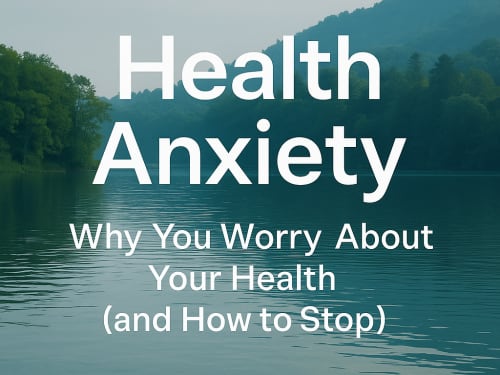Health Anxiety: Why You Worry About Your Health (and How to Stop)

posted 9th October 2025
🩺 Health Anxiety: Why You Worry About Your Health (and How to Stop)
If you struggle with constant worries about your health, you’re not alone, and it’s not “all in your head.” Health anxiety, also known as Illness Anxiety Disorder, can quietly take over your thoughts, leaving you trapped in a cycle of checking, reassurance, and fear. The more you seek answers, the less relief you feel.
🌿 What Is Health Anxiety?
Health anxiety happens when normal concern about your health turns into a persistent fear of illness, even when medical reassurance tells you otherwise. It’s more than simply “worrying too much”; it’s a psychological pattern that can feel all-consuming.
People with health anxiety might:
- Regularly check their body for changes, like lumps, tingling, or unusual sensations.
- Spend hours researching symptoms online — only to feel more anxious afterward.
- Seek reassurance from doctors, friends, or family — but find the relief is temporary.
Avoid medical appointments or health information altogether, out of fear of receiving bad news.
These behaviours often provide momentary comfort but reinforce the cycle of anxiety in the long term. The brain learns that the only way to feel safe is through checking, reassurance, or avoidance, all of which strengthen the anxiety over time.
📊 Health Anxiety by the Numbers
It might sound niche, but health anxiety is increasingly common — especially in the post-pandemic world.
- 🌍 Around 301 million people worldwide (roughly 4% of the global population) are living with an anxiety disorder — a rise of more than 55% over the last three decades (MeCP, 2023).
- 💭 The World Health Organization (2022) reported a 25% increase in anxiety and depression during the first year of the pandemic, reflecting how global uncertainty and health fears amplify anxiety.
- 🇬🇧 In England, about 22.6% of adults have symptoms of anxiety or depression. Among 16–24-year-olds, that number rises to 25.8%, up from 18.9% a decade ago (NHS Digital, 2024).
- 🩺 Research suggests 1.3–10% of people experience health anxiety specifically (Psychology Today, 2025).
- 🧬 In a 2024 study of medical outpatients, 23.7% showed signs of health anxiety — highlighting how often physical health concerns overlap with psychological distress (PubMed, 2024).
These numbers tell a clear story: health anxiety isn’t rare or attention-seeking — it’s part of a wider mental health challenge linked to uncertainty, medical misinformation, and the pressures of modern living.
⚖️ Illness Anxiety Disorder vs. “Hypochondria”
The old term hypochondria is outdated and often dismissive. It implied exaggeration or imagination, fuelling stigma around a very real condition.
In modern psychology, Illness Anxiety Disorder (IAD) is the correct term — one that acknowledges health anxiety as a legitimate form of anxiety disorder, not a personality flaw.
The DSM-5 (the diagnostic manual used by psychologists and psychiatrists) defines IAD as a persistent preoccupation with having or developing a serious illness, even when minimal or no symptoms are present.
The distinction matters. It validates that people with IAD are not overreacting — they’re experiencing genuine distress caused by misinterpreted physical sensations and anxious thought patterns (Ferguson, 2018).
🧠 Why Health Anxiety Happens
Health anxiety often arises from a mix of psychological, biological, and environmental factors.
1. Cognitive Biases
According to Aaron Beck’s Cognitive Theory of Anxiety, people with health anxiety tend to interpret normal body sensations as dangerous.
For example:
“My chest feels tight — maybe I’m having a heart attack.”
These automatic thoughts trigger fear, reinforcing the belief that danger is imminent. Over time, this “false alarm system” becomes the brain’s default setting.
2. Control and Uncertainty
Health anxiety often thrives when life feels unpredictable. Worrying about health gives a sense of control — even if it’s uncomfortable. It’s a way to prepare for the worst, but it keeps the mind in a constant state of alert.
3. Information Overload
In today’s world, we’re constantly bombarded with health information — online, on social media, and in the news. While access to knowledge is empowering, it can also fuel anxiety, especially when minor symptoms are linked to serious conditions.
💬 What Actually Helps
The cycle of health anxiety can feel relentless — but it’s possible to break free with evidence-based approaches.
🧩 1. Cognitive Behavioural Therapy (CBT)
CBT remains one of the most effective treatments for health anxiety. It helps you:
- Identify unhelpful thinking patterns (“What if this is something serious?”).
- Challenge fears using facts and alternative perspectives.
- Reduce reassurance-seeking and avoidance behaviours.
- Rebuild confidence in your ability to tolerate uncertainty.
Over time, CBT retrains the brain’s threat system to respond more calmly to bodily sensations.
🗓️ 2. Limit Reassurance and Googling
Endless symptom-checking can become compulsive. Set practical boundaries — for example, limit health-related searches to once per week or note symptoms before acting on them. This helps break the feedback loop that fuels anxiety.
🧘♀️ 3. Mindfulness and Relaxation
Mindfulness helps bring attention back to the present moment — away from “what if” thinking. Breathing exercises, meditation, or grounding techniques help reduce the body’s stress response and improve emotional regulation.
💬 4. Talk About It
Health anxiety often feels isolating. Talking with a therapist or even a trusted friend can reduce shame and normalise your experience. Therapy creates space to unpack fears without judgment.
⚖️ 5. Focus on Balanced Health Awareness
Health awareness is important — but balance is key. Instead of obsessing over symptoms, invest your energy in positive habits: exercise, sleep, hydration, and meaningful rest. These are the foundations of both physical and mental health.
It’s not about ignoring your health — it’s about finding peace with it.
📚 References
Abramowitz, J. S., & Braddock, A. E. (2011). Psychological treatment of health anxiety and hypochondriasis: A cognitive-behavioral approach. Guilford Press.
American Psychiatric Association. (2013). Diagnostic and statistical manual of mental disorders (5th ed.). Washington, DC: APA.
Beck, A. T. (1976). Cognitive therapy and the emotional disorders. New York: International Universities Press.
Ferguson, E. (2018). Health anxiety: The cognitive–behavioural perspective. Journal of Anxiety Disorders, 59(1), 1–6.
MeCP. (2023). Global burden of anxiety disorders 1990–2019. Meta-analysis of cross-national studies.
NHS Digital. (2024). Survey of Mental Health and Wellbeing, England 2023/24.
Psychology Today. (2025). Health anxiety prevalence and risk factors.
PubMed. (2024). Prevalence of health anxiety among medical outpatients: A cross-sectional study.
Rethink Mental Illness. (2025). Rates of people living with a common mental health condition on the rise in England.
Trends in the Epidemiology of Anxiety Disorders (Global Burden of Disease Study 1990–2021). (2024). Journal of Affective Disorders, 359(2), 24–36.
World Health Organization. (2022). COVID-19 pandemic triggers 25% increase in prevalence of anxiety and depression worldwide.





